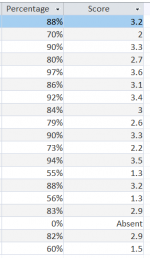Kayleigh
Member
- Local time
- Today, 01:41
- Joined
- Sep 24, 2020
- Messages
- 706
Hi there,
I have question which can be answered in Excel/Access - it is calculation, but since I am more familiar with Access VisualBasic I am asking it here. (Actually just stumbled on a very similar forum to this one - MrExcel.com which may prove useful with my Excel dilemmas.)
I would like to write a function which converts any given percentage into a grade following the grade system defined (this would vary depending on class so would I define table with this info first?)
I have tried mathematically working this out using ratios/percentages but could not think of a straightforward method to do this...
Would appreciate any ideas.
Sample conversion rates:
0 - 0%
1.0 - 45%
1.6 - 65%
2.3 - 75%
3.1 - 85%
3.7 - 100%
I have question which can be answered in Excel/Access - it is calculation, but since I am more familiar with Access VisualBasic I am asking it here. (Actually just stumbled on a very similar forum to this one - MrExcel.com which may prove useful with my Excel dilemmas.)
I would like to write a function which converts any given percentage into a grade following the grade system defined (this would vary depending on class so would I define table with this info first?)
I have tried mathematically working this out using ratios/percentages but could not think of a straightforward method to do this...
Would appreciate any ideas.
Sample conversion rates:
0 - 0%
1.0 - 45%
1.6 - 65%
2.3 - 75%
3.1 - 85%
3.7 - 100%

